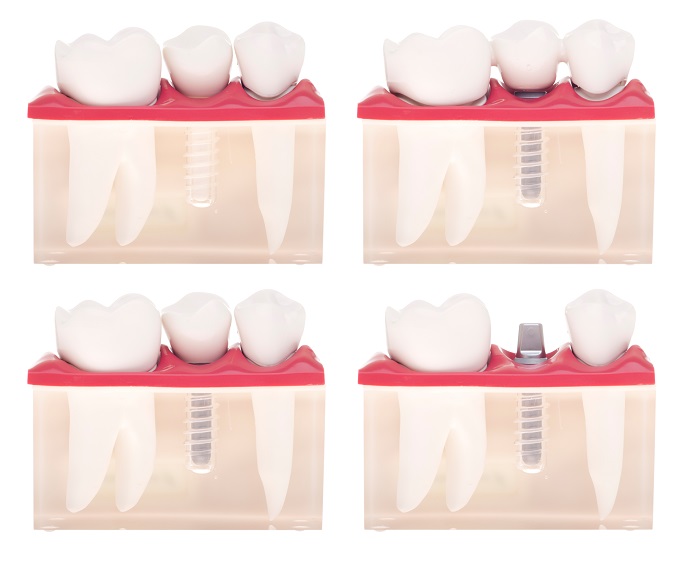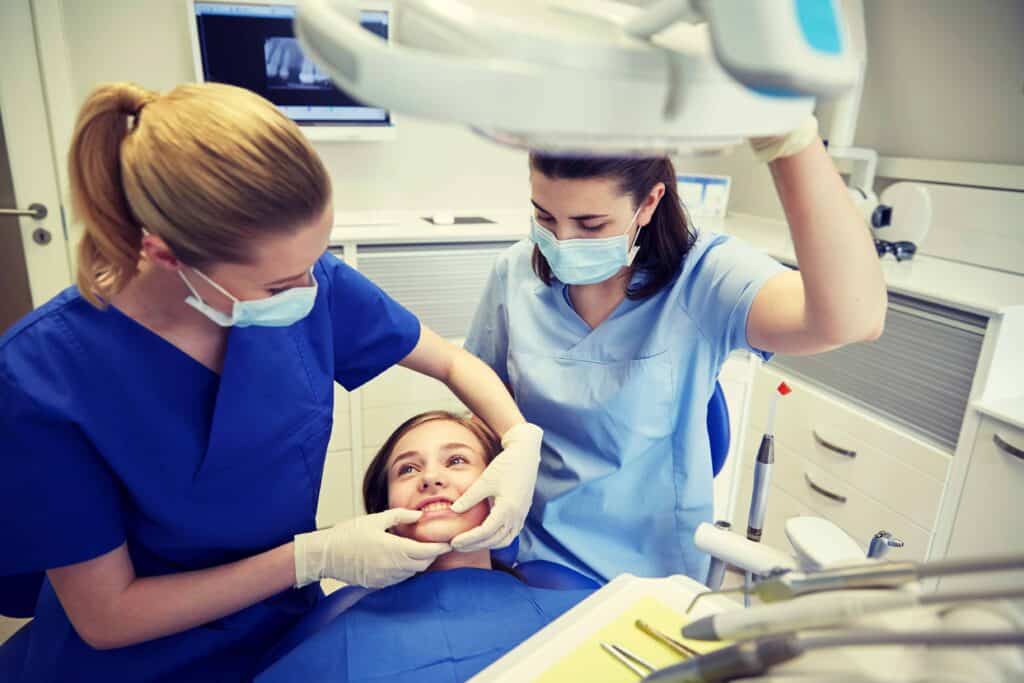Dental implant surgery is quite the involved and complicated procedure that makes many patients prefer availing of detachable dentures because of its comparative cheapness and simplicity.
However, computer guided (or computer-guided) dental implant surgery can prove to be a major game changer down the line for many. It makes available to the masses a way to make prosthetic teeth simulate the jaw-anchored bite of real teeth.
Let’s discuss what this new tech entails and also the pros and cons of computer guided dental implant surgery.
What is Computer Guided Implant Surgery?
Gone are the days of long wait times, the necessity of bone grafting on jawbones lacking enough density for oversized implants, and surgeons going blind when doing painful implant surgery that takes months to heal thanks to computer tech.
Computer-guided surgery involves using the cone beam CT scan on the patient to precisely plan out the implantation, making for a more accurate result when push comes to shove.
- Visualization and Guidance: An important aspect of computer guided implant surgery is visualization. The implant surgeon or dentist won’t go in blind and can manipulate images of the patient’ jawbone along with the surrounding tissue to map out the surgery.
- Careful Planning: The computer and CT scans all assist in helping the surgeon plan the most accurate approach to putting in the implant, thus giving way to things like soft-tissue implantation or implant surgery without bone grafts.
- More Precision and Less Guesswork: There’s less guesswork and estimates involved with the computer guidance and advanced scanning tech involved. This enables surgeons to view surrounding tissues, teeth, and the landscape of the jaw.
- Less Cuts and More Healing: Surgeons won’t have to cut any deeper than needed because they won’t have to dig around for the empty tooth socket. They know where it is through the scan and the software. Placement is as precise as placing gears on a watch.
- Accuracy is the Whole Point: Any circumstances where increased accuracy is required for implantation or implant surgery because of its complexity could justify the price of computer guided implantation. The tech used for planning such a treatment allows surgeons to map out position and morphology.
Pros and Cons of Computer Guided Dental Implant Surgery

A good dental center doesn’t do dental implant surgery blind or freehand. That increases the chances for mistakes and expensive corrections down the line. It’s much better to set things up with a 3D image or map of what the surgeon will work with.
Therefore, getting computer guided dental implant surgery with CT scans and 3D models entails the following benefits:
- You’re provided a 3D CT scan image of your jaw.
- It helps make implant surgery pain-free and more comfortable.
- The Cone Beam CT scan helps piece together an implantation plan.
- Highly specialized PC software further aids in mapping out the surgery.
- The surgery becomes more predictable, safer, and quicker thanks to this.
- There’s less need for bone grafts and soft-tissue implants become more viable.
- Even if you’ve suffered jawbone loss you can still get implants with this method.
- The computer assistance helps in precise placement of implants on pre-planned areas and whatnot.
- As a surgeon, you’ll know where to go and what to do while accomplishing more comprehensive surgeries.
- Implants can now be placed in places that they couldn’t be placed before this technology came into existence.
Nothing is absolutely perfect. No matter how advanced this computer-guided implant surgery procedure gets, it also comes with several drawbacks though, which includes the following:
- It’s not necessary for all types of implant dentistry and most opt out of it.
- Surgeons and dentists also require extra training to use computer assistance.
- It costs both the dental center and the dental patient a bundle to avail of this method.
- It’s a heavy investment for the patient to compound implant surgery fees with a CT scan and 3D imaging.
- Surgeons have to shoulder the initial cost of investment for planning software and specialized surgical equipment.
- As quick and comfortable as this implant surgery type is for patients, clinicians will have to do extra work in planning the surgery compared to traditional implantation.
One way to lower the costs of implant dentistry when compared to stateside American healthcare prices or even the universal healthcare available in the European Union or Canada is to avail of Thailand’s dental tourism.
When all is said and done, the overall benefits of computer guided implant surgery outweigh its expensive drawbacks as long as you can afford it. Here are some of the many benefits that it offers:
- Faster healing or recovery.
- Treatment that’s accurate and precise.
- Damage prevention of vital oral and dental structures.
- Minimal pain due to the involvement of minimal incisions.
- Better aesthetic outcomes because the implant looks and feels completely natural.
What’s Involved in the Computer Guidance Process?
Just as x-rays and CT scans served as serious game changers in the medical world, so too should computer guided implant surgery. This process allows dentists and surgeons to view the jaw’s overall anatomy from the start.
The overall process of computer-aided implantation includes the following steps.
-
Overall Scan of your Jaw Area: Your jaw area will first be scanned with a sophisticated Cone Beam CT scanner. This allows dental surgeons to end up with a three-dimensional image of the jaw area.
This includes your sinus cavities, nerve tissues, bone quality and quantity (as in bone density or lack thereof), exact teeth positions, and the jaw itself. This allows for a more mapped out process.
-
Creating the 3D Model of Your Jaw: One the computer gets that CT scan, it will then use highly specialized software from Nobel Biocare in order to make a 3D model of your jaw.
This in turn assists in virtually placing the implant or implants in the most ideal positions possible. The surgeon doesn’t need to go blind or do more cuts in order to safely place the implant into your jaw and empty tooth socket.
-
Prepare the Drilling Guide: The 3D model featuring the virtual placement of the implant is then sent to a specialized laboratory that prepares a drilling guide for the surgeon to use.
The guide helps during surgery in precisely placing the implant into the jaw or even soft tissue with as minimal cuts and invasion of your gums and bone as possible.
-
The Implant Process Itself: After they’ve got the drilling guide on hand, implant surgeons can now use it to place the implant precisely at the best position, involving the least amount of cutting and surgery.
It’s guides like this that allows the surgeon to do implantation on the same day. Some dental centers even use dental lasers to make the surgery even more minimally invasive because it promotes healing and reduced swelling.
What are the Origins of This Implant Technology?

Computer-guided or computer-assisted implant technology was originally developed with neurosurgery in mind, since nerves are much smaller and more sensitive, thus requiring even more precise cuts in order to work.
- Predictable and Safe: Predictability in movies or advertising might be a bad thing, but as far as dental implants are concerned that’s a good thing. The predictability of computer-guided surgery makes things simpler and safer.
- Only a Select Few Use This: A low number of dentists and surgeons make use of computer assistance in doing implant surgery because while safer than traditional means, the standard remains good enough for them and they don’t feel like the extra training investment is necessary.
- Fifteen Thousand Guides in 2012: Back in 2012, only 15,000 computer-generated surgical guides were utilized from the millions of people who avail of implant surgery. To be more specific, 2 million implants were placed and only 15,000 of those required computer guidance.
- Thirty-One Thousand Guides in 2019: Before the pandemic, the amount of guides rose to 31,000 by 2019. However, it’s still a remarkably low number compared to implant surgery’s growing popularity.
- Images from Cone Beam CT Scan: The images from the cone beam CT scan of the patient is used to make computer guided implant surgery possible. The guide is based on this data.
- Everything is Seen: The CT scan clearly shows the root anatomy, proximity of adjacent teeth, the thickness of soft tissues, the density of the bone, all the vital structures, and so forth versus just bone with x-rays.
- Guided Surgery Allows for Manipulation: Surgeons can see and manipulate the CT scan images of the patient’s jawbone as well as surrounding tissue and teeth structures, allowing them to map out the best and easiest approach.
- Laser Technology: The inclusion of the dental laser used in tandem with the drilling guide also obviates the need for stitches after all is said and done. Everything has been developed to become more precise and more streamlined.
When is Using Computer Guided Implant Surgery Advisable?
Using computer-guided implant surgery is most advisable if you need three or more implants to be placed in sequence. If you’re availing of one of those all-on-4, all-on-6, or all-on-8 packages, it might be worth investing in computer-guided surgery.
- Achieve a More Desirable Outcome: Using CT scan and computer guidance for your dental surgery allows you to get the best outcome with more precision and higher rates of success, especially if the implant is critical in anchoring your bridges or dentures.
- Bone Density Issues: If you have bone density issues and wish for an alternative to the extra cost of bone grafting, you can use computer-aided surgery in order to place the implant without grafting included. It can also assist in bone anatomy that requires significant alterations or drilling.
- Immediate Extraction or Fully Edentulous Mouths: Patients who are fully edentulous (toothless) or who require immediate tooth extraction followed by implantation could be good candidates for computerized or computer-aided surgery.
- Anything Requiring Minimal Invasiveness: Implant dentistry is invasive by nature because it involves cutting through gums, tissue, and nerves to get to the bone and tooth socket, which is where you screw the implant in. The CT scan assistance helps reduce invasiveness using measured and precise cuts.
- If Other Implants are Involved: You should also go for computer-guided surgery if the implants being put on your mouth are in close proximity with each other or adjacent teeth. The additional data and details should help the surgeon plan out everything in the most optimized way possible.
- Not Required in All Scenarios: Although advantageous, it’s not needed for all implantation cases and circumstances. Another reason why so relatively few implants are done with computers and CT scans involved is because dentists can successfully and routinely place implants without guides in a freehand manner.
What are the Earmarks of Excellence of Implant Surgery?

You can make sure to avoid vital anatomical structures and nerve damage by using the best possible computer guided route with software assistance to fully see what you’re about to go through in terms of anatomical visualization.
Surgeons get to preview the surrounding anatomy of implant sites while making sure the implant is placed in the most ideal position possible.
- For Planning Out Restorations: Instead of coming up with a crown or bridge after the fact, you can plan out the position and morphology of your planned restorations even before the implant is placed in your mouth in the first place, thus everything becomes safely predictable from the beginning.
- Reverse-Engineering Implant Surgery: The data made available by the CT scan and how it’s parsed by specialized software all work hand-in-hand in order to allow you to reverse-engineer implant surgery, which you normally can’t do.
- Visualization and Approval: By being able to preview the treatment plan, you and your dental team can correct, approve, or reject a surgical approach to implantation. You can come up with better final prosthesis as well in light of data.
- Dealing with Small Deviations: It’s normal to end up with small deviations from the guide. However, the deviations are mostly miniscule and you will still end up with more accurate placement of the implant compared to freehand surgery.
- You Have Fewer Adjustments Needed: Most experienced dental technicians doing freehand surgery have to adjust planned restorations to make the implants fit in less-than-ideal circumstances, including soft-tissue implantation. You have fewer issues with this when doing it with a computer guide.
- Custom Abutments: The abutments help the restoration dentures or bridges fit better on less-than-ideally placed implants on your mouth due to the circumstances surrounding your jaw density. Computer-guided surgery makes them less necessary due to CT scan data.
- Permanently Replaces Teeth: Aside from computer assistance, it’s important to remember that implant treatment permanently replaces permanent teeth. They can simulate the way natural teeth are anchored to your jaw the way removable dentures never could.
- Bring Back Your Smile: You can get back the smile you’ve (literally and figuratively) lost by availing of the extra-safe and carefully planned computer guided implant surgery—a true dental game changer for the last 10 years.
In Summary
Dental centers like Thantakit offer the most advanced in computer guided implant surgery without having it cost an arm and a leg when push comes to shove because Thailand has one of the most cost-effective healthcare systems on earth too.
Although dentures are known to be cheap like eyeglasses are cheaper compared to LASIK surgery, the combination of computer guided dental implant surgery and Thailand dental tourism allows you to get the dental version of LASIK relatively cheaply and much safer than before.
Thantakit International Dental Center is Thailand’s longest established dental center. Situated in Bangkok, our clinic is renowned across the world as a destination for world-class dentistry, with most of our patients flying to us from Australia.
Get in touch with us today and get a FREE dental consultation.












